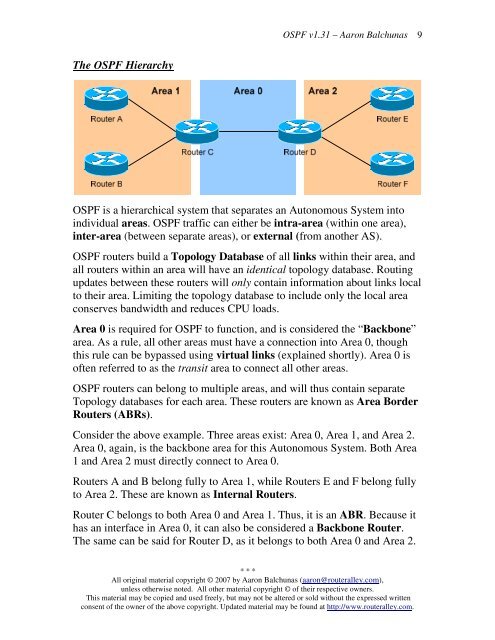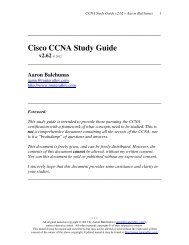Open Shortest Path First (OSPF) - Router Alley
Open Shortest Path First (OSPF) - Router Alley
Open Shortest Path First (OSPF) - Router Alley
Create successful ePaper yourself
Turn your PDF publications into a flip-book with our unique Google optimized e-Paper software.
<strong>OSPF</strong> v1.31 – Aaron Balchunas<br />
9<br />
The <strong>OSPF</strong> Hierarchy<br />
<strong>OSPF</strong> is a hierarchical system that separates an Autonomous System into<br />
individual areas. <strong>OSPF</strong> traffic can either be intra-area (within one area),<br />
inter-area (between separate areas), or external (from another AS).<br />
<strong>OSPF</strong> routers build a Topology Database of all links within their area, and<br />
all routers within an area will have an identical topology database. Routing<br />
updates between these routers will only contain information about links local<br />
to their area. Limiting the topology database to include only the local area<br />
conserves bandwidth and reduces CPU loads.<br />
Area 0 is required for <strong>OSPF</strong> to function, and is considered the “Backbone”<br />
area. As a rule, all other areas must have a connection into Area 0, though<br />
this rule can be bypassed using virtual links (explained shortly). Area 0 is<br />
often referred to as the transit area to connect all other areas.<br />
<strong>OSPF</strong> routers can belong to multiple areas, and will thus contain separate<br />
Topology databases for each area. These routers are known as Area Border<br />
<strong>Router</strong>s (ABRs).<br />
Consider the above example. Three areas exist: Area 0, Area 1, and Area 2.<br />
Area 0, again, is the backbone area for this Autonomous System. Both Area<br />
1 and Area 2 must directly connect to Area 0.<br />
<strong>Router</strong>s A and B belong fully to Area 1, while <strong>Router</strong>s E and F belong fully<br />
to Area 2. These are known as Internal <strong>Router</strong>s.<br />
<strong>Router</strong> C belongs to both Area 0 and Area 1. Thus, it is an ABR. Because it<br />
has an interface in Area 0, it can also be considered a Backbone <strong>Router</strong>.<br />
The same can be said for <strong>Router</strong> D, as it belongs to both Area 0 and Area 2.<br />
* * *<br />
All original material copyright © 2007 by Aaron Balchunas (aaron@routeralley.com),<br />
unless otherwise noted. All other material copyright © of their respective owners.<br />
This material may be copied and used freely, but may not be altered or sold without the expressed written<br />
consent of the owner of the above copyright. Updated material may be found at http://www.routeralley.com.

















